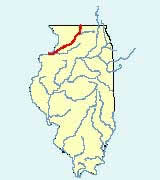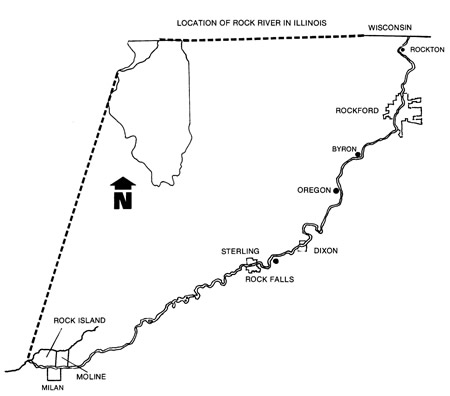Choose another river
Rock River


©Illinois State Water Survey
Location: The Rock River begins just to the west of the village of Brandon in Metomen township, Fond du Lac County, Wisconsin and flows southward to the Illinois border ending 325 miles later at the Mississippi River at the Quad Cities in Illinois and Iowa. The river drains 10,280 square miles with about half of this area in Illinois. The Illinois portion of the river has major population centers at Rockford, Dixon, Sterling/Rock Falls, and Rock Island. The remainder of the Illinois portion of the basin is primarily agricultural. The Rock River has low-head dams at Rockton, Rockford, Oregon, Dixon, two at Sterling/Rockfalls, and a split dam at Milan.
Description: The Rock River, which winds 155 miles through northwestern Illinois, is one of the main tributaries to the Mississippi River and provides a diverse fishery. The river provides an aquatic resource of about 12,400 acres as it glides past towns like Rockford, Oregon, Dixon, Sterling and Rock Island before spilling into the Mississippi. Dams at Rock Island, Milan, Sterling, Dixon, Oregon, Rock-ford and Rockton produce fast, turbulent water, and these tailwaters are good spots for walleyes, sauger and white bass.
The river generally averages about 15 feet in depth in the main channel, but between Dixon and Sterling, depths may drop to 50 feet. The bottom is largely bed rock, but there are extensive gravel areas and some places where the bottom is covered with a layer of mud or silt.
From where it departs, Wisconsin to the mouth of the Kishwaukee River, the prime fishing spots are the dams at Rockton and Rockford and the tributary streams, which include the Pecatonica River and Willow Creek. Ramps are located in the Forest Preserve at Rockton, at Harlem Road south of North Park and at Blackhawk Park south of Rockford. There is a small forest preserve just upstream on the south bank of the Kishwaukee.
Pools where the Leaf River enters south of Byron is a good fishing spot as is the water above Oregon and at the dam there. Ramps are located at Byron and Lowden State Park at Oregon where there also is camping with electrical hookups. Ramps are available at Lowell Park on the west bank along Ill. Route 2 north of Dixon, at Page Park in Dixon and Oppold Marina north of Sterling.
Ramps are also located in Sterling, Rock Falls, at a roadside park downstream along Route 2, at Prophetstown State Park where camping and electrical hookups are available, and at the Erie Boat Club.
There are a few access areas south of Erie, and anglers will find many small islands as the stream flows through low farmland. Fishing should pick up where the Green River enters below Green Rock.
Status of the Sport Fishery: Bluegill were collected at all of the main-stem stations and at 8 of the 10 tributary stations. The best numbers were found at Rockton, below the dam in Rockford, and at Moline. The majority of these fish were less than 5" but a few were in the 6-7" range. The largest Bluegill were collected below the dams in Rockford and Dixon, and in the Atwood Homestead Forest Preserve.
Walleye, Crappie, and Northern Pike were collected at several stations but only in small numbers. Walleye are stocked each year in the upper end of the Rock River, and this has resulted in a quality fishery throughout the river. State record Walleye have been caught in the Rock River near Rockton, and in the mouth of the Pecatonica River on several occasions. Walleye are not generally collected during daytime electrofishing surveys, and are usually sampled after dark. Walleye surveys are performed every other year on the Rock River, but the high water levels in the fall of 2018 prevented the survey from being conducted.
Threatened and Endangered Species: Three threatened species, the Gravel Chub, Banded Killifish, and River Redhorse, and one endangered species, the Weed Shiner were collected from the Rock River main-stem during this survey. The Weed Shiners were collected at two stations, the first near Prophetstown State Park, and the second near Erie. The Banded Killifish were collected near Prophetstown. Banded Killifish were first found near Prophetstown in 2013 and they have apparently established a small population since they have been found several times in this same area since. Gravel Chubs were collected in South Beloit, Oregon, and Sterling. Gravel Chubs have historically been found from South Beloit to Byron, but the collection of this species near Oregon and in Sterling is rare. There were no threatened or endangered species collected from the tributary stations, although Banded Killifish have been collected in the past near Milan, IL in Mill Creek.
Fishing Outlook ( Full PDF Report )
Click here for a list of all reports.
Species |
Rank |
Fish Status |
Excellent | Channel catfish are extremely abundant in the Rock River in most all areas. In 2017 a survey was done on the Rock River from Dixon to Sterling to check the status of the channel catfish. Data from a total of 244 channel catfish were collected. The largest numbers of channel catfish were collected below the Sterling Lower Dam where there was a catch rate of 8.7 fish/net night. The fish collected ranged in size from 11 to 30.7 inches, with the majority collected (83%) over 16" in length, and 21% of these over 24". This is great news for fishermen looking for good size fish. The largest catfish collected was just over 30" in length and weighed 11.4 pounds. The average weight of the fish collected in this study was 3.78 pounds. | |
Excellent | The Rock River is one of the best rivers in the state for catching trophy size flathead catfish. A survey was done in 2018. Sites were all sampled using an electrofishing boat, which is generally less effective at collecting catfish due to their propensity to dwell near the bottom of the river. However, even though electrofishing generally doesn’t target catfish, a total of 108 flatheads were still collected. A total of 72 adult fish were collected, with 42 over 16", 14 of preferred size (over 24"), and 11 of memorable size (over 28"). Six of the fish collected were in the trophy range (over 36"), representing 8% of the adult sample! The majority of the flathead catfish collected were found in the lower end of the Rock River, from Castle Rock State Park to Moline, with the largest number collected near Prophetstown State Park. The average size of the adult fish collected was 20”. | |
Very Good | Smallmouth bass are common and abundant in the Rock River. A survey done in 2018 found the overall catch per unit of effort (CPUE) was 0.6 fish/ minute. This is quite good since bass were not the primary target. The Catch/Unit of Effort (CPUE) for stock size fish (those over 7”) was 0.5 fish/ minute. The number of fish over 14” (preferred size) was within the acceptable range. The largest individuals collected were over 18” in length (trophy size) near Prophetstown, as well as near Grand Detour. Other good areas are below the dams in Rockford, Dixon and Oregon. | |
Very Good | Walleye are stocked each year into the Rock River to provide a quality sport fishery for this species. Fishing is generally good below the dams and at the mouths of the tributaries. Walleye ranging in size up to and over the state record weight have been caught in recent years in the upper Rock River and the Pecatonica River, a tributary of the Rock near Rockford. A survey conducted in the fall of 2016 near Dixon found a catch rate of .5 fish/ minute with a total of 53 fish of all sizes collected in 110 minutes, well over the target rate for stocking success. The largest collected was just over 5.6 pounds. Fishermen regularly report catching memorable size walleye from Sterling up through Rockford. Best fishing for walleye is in the upper Rock River, north of Rockford however anglers report good fishing near Dixon and at Prophetstown State Park. | |
Fishing Regulations: *Consult the current Illinois Fishing Regulations Booklet for more detailed information.
Species |
Creel Limit |
Minimum Length Limit |
Black Bass (Largemouth, Smallmouth) Entire river including tributaries in State of Illinois. |
6 singly or in combination with no more than 3 smallmouth bass in the daily creel |
14" for Smallmouth Bass |
Walleye, Sauger, or Hybrid Walleye Wisconsin state line downstream to the Sears and Steel dams at Milan |
6 either singly or in combination |
14"minimum length limit |
Walleye, Sauger, or Hybrid Walleye Sears and Steel dams downstream to confluence with Mississippi River, State of Illinois (Rock Island County). |
6 fish daily creel with no more than 1 walleye greater than 27" in total length |
15" minimum length limit with a 20-27" protected Slot Length Limit. |
Northern Pike |
3 fish daily creel |
24" minimum length limit |
Note: There is a closed season on smallmouth bass. All smallmouth bass caught between April 1 and June 15 must be immediately released alive and in good condition back into the waters from which they came.

Rock River Fishing Reports
Multiple day tournaments are listed with * end date.
Interested in participating in one of these public tournaments? Contact us with tournament ID for more information.
| 2025 Approved or Pending Tournaments | ||||||||
| Start Date | ID | Approval | Ramp Location | Bank/Boat Hook/Bow |
Max Boats | Species | Youth? | Open to Public? |
| June-14*June-15 | 28694 | Approved | Martin Park | boathook | 30 | Channel Catfish Flathead Catfish | No | Yes |
| June-21*June-22 | 29079 | Approved | Erie Boat Ramp | boathook | 20 | Channel Catfish Flathead Catfish | No | Yes |
| August-09*August-10 | 28695 | Approved | Martin Park | boathook | 30 | Channel Catfish Flathead Catfish | No | Yes |
| October-05 | 28696 | Approved | Martin Park | boathook | 30 | Channel Catfish Flathead Catfish | No | Yes |



